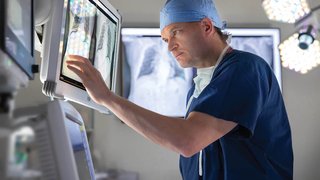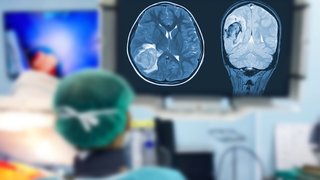
Red, raised scars from burns, trauma, or surgery can cause pain and discomfort that reduce your quality of life even decades after the original injury.
These hypertrophic scars (often red, raised, tight and itchy) form when the body is in a state of inflammation after an injury. The body tries to heal by rapidly laying down fibers of collagen, a protein that builds new skin and connective tissue. But these fibers often get arranged haphazardly. Instead of soft, pliable new skin, your body develops raised, stiff tissue that is prone to burning, tingling, numbness, and nerve pain.
In the past, patients with hypertrophic scars had limited treatment options. A surgeon could cut away the raised tissue, but that would leave another scar in its place.
Laser technologies have significantly changed how we approach hypertrophic scar treatment. These procedures break down scar tissue so it can heal in a smoother, flatter, and more comfortable pattern while improving the appearance of the skin.
The Comprehensive Scar Program at UT Southwestern offers the latest technology in scar reconstruction, including four types of sophisticated laser therapies that require next to no downtime after treatment sessions.
Patients at UT Southwestern, Parkland Health, and Children’s Health can get complete scar care – from acute burn and post-surgery scar management through scar reconstruction and rehabilitation – with our collaborative team. Specialists in plastic surgery, burn reconstruction, and physical medicine and rehabilitation (PM&R) can create a personalized laser treatment plan to help you feel and look more like yourself again.
Advanced laser therapy for hypertrophic scars
Carbon dioxide fractional ablative laser (CO2 laser) technology is a hallmark of scar reconstruction. UTSW uses the Lumenis UltraPulse, which creates not-quite-microscopic punctures in the scar tissue.

Distressing the scar tissue and breaking up the abnormal collagen in this way invites the patient’s body to re-heal the area in a more organized fashion. This fractionated laser therapy delivers energy to just 3%-10% of the actual scar area. The remaining skin absorbs some of the heat, which activates skin stem cells to stimulate new collagen growth – as if the treatment “spreads” throughout the scar tissue.
In addition to the Fractional CO2 laser, which helps with the scar thickness, tightness and itching, the Cutera laser can target and improve the redness that is often associated with scars.
The CO2 laser at UTSW is equipped with an upgraded handpiece, SCAAR FX, which is not widely available at community clinics. This addition allows us to penetrate deeper into thick scars for more comprehensive healing.
While laser treatment doesn’t remove the scar, it replaces the original tissue with a flatter, less symptomatic, and less noticeable scar. CO2 laser treatment can also release trapped nerves in the scar tissue, relieving nerve pain.
What to expect
Leading up to treatment, you’ll be asked to make a few lifestyle adjustments:
- Avoid extensive sun or tanning exposure to the scarred area – you cannot get laser therapy on sunburned or tanned skin.
- Quit smoking at least two weeks in advance to optimize healing.
- Avoid products that contain vitamin E, aspirin, retinoid, or glycolic acid for two to four weeks before the procedure. Talk with your doctor about your specific medications.
- Don’t wear lotions, perfumes, makeup, or other products that create a barrier between the laser and the skin on the day of the procedure.
Because the laser produces significant heat, this procedure is done in the operating room under sedation or general anesthesia. You won’t be in pain when you wake up – most patients say it feels like a temporary sunburn and don’t need pain medication after treatment. You can go back to work with no restrictions on the same day if you wish.
Sessions take 30-90 minutes depending on the size of the scar and your healing progress. You may have some minor, temporary side effects such as:
- Light bleeding
- Swelling
- Skin crusting
- Skin discoloration
Some patients will begin to see improvements in scar symptoms and appearance after the first session. Most people need two to five total treatments over several weeks, depending on the severity of the scar.
More advanced scar laser treatments
UTSW offers three other scar laser technologies for mild hypertrophic scars. Because these therapies use less intense heat, they are given in the clinic and not in the operating room:
- CUTERA Secret Pro, which uses a lower-energy fractional laser and radiofrequency microneedling to reconstruct scar tissue affected by erythema, or redness, caused by inflammation and increased local blood flow at the scar site.
- SCITON Profractional, which we use for patients with a history of ingrown hairs to guide new collagen channel development and reduce hair follicle complications in the new scar tissue.
- Erbium-YAG, which is a resurfacing device that works similarly to CO2 technology but with a lower energy output. It ablates skin layer by layer, so we can give more precise treatment in smaller, thicker scars.
Laser scar procedures are not painful. You will get topical anesthesia on the affected area, and most patients can resume normal activities the same day without restrictions.
Who should not get scar laser treatment?
Patients who take oral retinoid medications to treat acne or who are immunocompromised may not be eligible for laser scar treatment due to a risk of delayed healing. Patients who are pregnant, breastfeeding, or getting treatment for another skin condition should talk with their specialist about the risks and benefits before laser therapy.
People who are prone to developing cold sores should take antiviral medication for a few weeks leading up to treatment, since the herpes simplex virus can be stimulated by the laser’s light. Patients with a history of keloids are not eligible because the treatment will likely lead to a bigger, more obtrusive scar.
Related reading: Keloid scars: Advanced therapies and research to break the ‘overhealing’ cycle
Scar care over the long term
Burn, injury, and surgical scar reconstruction is one of the few treatments where delaying therapy can result in better outcomes. New scar tissue is very vascular, which means it has a lot of blood vessels that can be prone to bleeding. We typically start laser scar reconstruction about six months after the initial injury. However, laser treatments can still flatten scars after 20 years or more.
UTSW patients have access to a full range of long-term burn and scar treatment and rehabilitation. Along with laser therapy, we offer:
- Z-plasty surgery for large, highly symptomatic hypertrophic scars. The surgeon makes a Z-shaped incision in and slightly around the scar tissue to create skin flaps that are rearranged to reduce tension and lessen pain symptoms. In some cases, we place a skin graft or relocate donor tissue from another part of the patient’s body to reconstruct the scarred tissue.
- Burn rehabilitation support through our PM&R department and our partnership with Parkland Health, which has one of the largest Burn Centers in the U.S. Patients can get pain management, mobility therapy, and acute and long-term skin and scar tissue management in our multidisciplinary program.
- Care navigation, which is guided by nurse navigators who help patients schedule visits and answer questions about day-to-day burn and scar management.
UT Southwestern established the North Texas Burn Rehabilitation Model System (NTBRMS), an internationally recognized model for integrating research findings at the bedside. Through NTBRMS, our patients get access to the latest in burn rehab therapies before they are widely available in community clinics.
For example, we are enrolling in research studies to learn whether laser therapy can improve thermal regulation in patients with burn scars. Significant burns can damage the sweat glands, keeping patients from sweating – which is how our bodies keep cool in hot environments. Our research will observe whether laser treatment can also reactivate the sweat glands and reestablish temperature self-regulation.
Hypertrophic scars can be painful and annoying – but they don’t have to keep disrupting your life. Talk with a burn specialist or plastic surgeon about your scar reconstruction options and how laser therapy could help you feel and look more like yourself again.
To discuss scar laser therapy options, call 214-645-8300 or request an appointment online.












